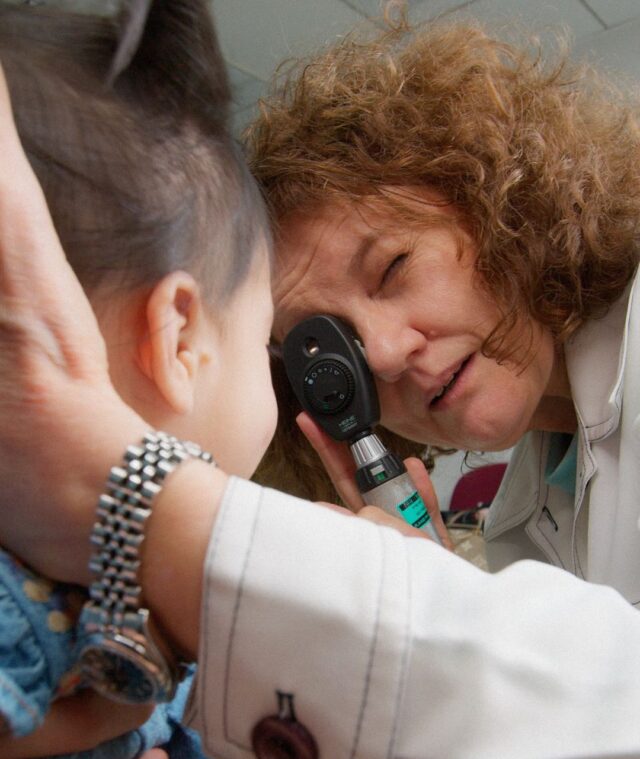Photo by Alexander Dummer on Unsplash
Technology changed a lot of things, and that includes how children pass the time. Today, kids are allowed and thus more inclined to play on their smartphones or computers rather than go outside. They are happy to use their devices until it’s time to go to bed – often later than appropriate for age too.
But while this has become a familiar pattern for the young generation, it doesn’t make it a good habit. In fact, it is far from being an eye-friendly practice due to the amount of blue light exposure they get from these gadgets.
In this article, you will learn the effects of blue light and some tips on eye care for children so you can protect your little one’s eyesight.
The Effects of Blue Light
Numerous warnings have been made public against the constant use of digital screens because of the blue light they emit. This gave blue light a negative reputation in terms of eye health.
However, you must remember that blue light is not inherently bad.
The truth is that blue light helps boost alertness and enhance a person’s mood. It also supports cognitive function and memory and plays a vital role in regulating the circadian rhythm or the natural sleep cycle.
What made blue light look bad is the effects of overexposure to it.
Ever heard of digital eye strain? Also called “computer vision syndrome,” this condition is the result of excessive use of digital devices for people of any age.
Children may also experience sleep disorders, blurry vision, headaches, and several other conditions after being exposed for too long to blue light. Early action is the key to preventing all these.
How to Protect Children’s Eyes From Blue Light
To ensure your children’s eye health, we’ve compiled three things you can do to protect them from blue light:
1. Establish age-appropriate boundaries
Considering that blue light isn’t all that bad and that too much exposure makes it harmful, the obvious first step you must take in protecting your children’s eyes is to limit their gadget use.
It doesn’t matter what kind of screen they are using. You must regulate your children’s exposure to tablets, mobile phones, laptops, TV, and just about anything with blue light-emitting screens.
Below is a quick guide to the safe use of digital screens based on recommendations from the American Academy of Pediatrics:
- Two to five years old – Entertainment-based screen time should be limited to a maximum of one hour per week
- Infants to age two – No screen-time at all
In the past, children aged six years or older got a maximum of two hours of screen time daily. However, this has changed to allow parents to decide on an appropriate limit that will work for their family. It is still wise to limit this as much as possible.
The key is to ensure that screen-time is not prioritized over physical activity, physical interaction, and sleep, and must be consistent.
Take note that limiting digital device use is particularly important before bedtime. It would be best to keep your children off gadgets for at least two hours before going to bed to ensure it doesn’t affect their circadian rhythm.
2. Maintain a safe distance from digital screens
Besides the length of time of screen exposure, you also need to monitor your child’s distance from the screens of the devices they use.
In recent years, the occurrence of myopia in children has increased exponentially. While studies have yet to establish a direct link between the condition (more popularly known as nearsightedness) and screen usage, data gathered by the American Optometric Association implies that the number of children with myopia increased to 25 percent in 2018.
The condition can increase a child’s risk of other eye conditions such as glaucoma, cataract, and retinal detachment or macular degeneration.
If your child already has this condition, some of the myopia control solutions you can try are:
- Low-dose atropine eye drops – can be difficult to maintain
- Orthokeratology (Ortho-K)
- Multifocal contact lenses – different version as needed in older adults
You need to manage nearsightedness early on to keep it from getting worse. If prevention is still possible, make sure that you grab the opportunity while you still can.
One important thing you can do is control your child’s viewing distance from the digital screen.
When reading, the ideal distance between the eyes and the material is 16 inches. However, with gadgets – especially phones – kids often keep only 10 to 12 inches away from the material.
When this happens, the eyes turn in to focus on the screen instead of staying in a relaxed position when looking further away. This can cause eye muscle fatigue, which can then lead to headaches and an array of eyesight problems.
3. Enhance macular pigment
The macular pigment is the eyes’ blue light-absorbing tissue. Three types of carotenoids comprise this thin layer of yellowish tissue located at the macula (the center of the eye): zeaxanthin, meso-zeaxanthin, and lutein.
Supplementing these carotenoids, along with eye-friendly nutrients, can help strengthen the eyes’ defenses against blue light.
Check whether your child’s diet provides a healthy amount of macular pigment. Here’s a list of the nutrients necessary to ensure eye health and the best food sources of each one, according to Harvard Health:
- Lutein and zeaxanthin – These are found in Brussels sprouts, broccoli, kale, romaine lettuce, spinach, nectarines, oranges, papayas, corn, eggs, and squash.
- Omega-3s – Excellent sources of this type of fatty acids include flaxseed, walnuts, halibut, salmon, sardines, and tuna.
- Vitamin A – Some foods rich in this vitamin are raw cantaloupe, carrots, sweet potatoes, apricots, mangos, ricotta cheese (part-skim), raw red peppers, and spinach.
- Vitamin C – Foods rich in this vitamin include cruciferous vegetables (e.g., broccoli and Brussels sprouts), red peppers, and some fruits like kiwi, grapefruit, oranges, and strawberries.
- Vitamin E – Your child can get his daily vitamin E needs from almonds, butter, peanut butter, sunflower seeds, broccoli, spinach, and wheat germ.
- Zinc – Chickpeas, red meat, oysters, and yogurt are all rich sources of this nutrient.
Protect Your Children’s Eyes
Children’s eyes are more vulnerable to the harmful effects of blue light. Make sure your little one’s eyesight isn’t compromised by following these tips and seeking expert eye care advice from Gulf Eye Center.








